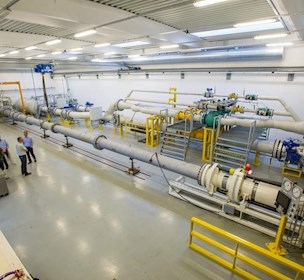8 things to remember when shipping flowmeters to a calibration facility
Shipping flowmeters for calibration purposes to a facility abroad is a routine for some and a struggle for others. Here are our best tips on what to consider when shipping your flow meter.
1. Inspect the flow meter before shipping it
If your meter arrives at the calibration facility damaged or leaking, calibration is not possible, or the results can be misleading. Before shipping, you can save a lot of time and money by checking the meter for leaks, damages, or disturbances in calibration signals like pulses and mA.2. Use suitable packaging
Make sure your flowmeter doesn't get damaged in transit by wrapping it up carefully and using a solid packaging box assembled with screws, not nails. This makes it easier for the calibration facility to reuse the package when returning your meter and protects it from damage.3. Provide complete and accurate information
The paperwork is essential, whether you cooperate with a freight forwarder or not. Details regarding the flowmeter size, weight, dimensions, value, country of origin, destination and business information affect the duties and customs fees at the ports and help eliminate the risk of inaccuracy. Being thorough with this information is often the foundation for a successful shipment to and from the facility.4. Inside or outside the EU?
Custom duty rules can be tricky, especially when shipping to or from countries outside the European Union. First, ensure the flowmeter has the appropriate customs clearance to enter and exit the country in question. Within the EU, accurate information about your meter often suffices. Across the EU borders, filing a proforma invoice (also known as a commercial or temporary invoice) containing adequate information for determining custom duties is vital. The best solution is to obtain a temporary import authorisation or a customs authorisation for inward processing, secure duty and Vat Exemption for the calibration units. Freight forwarders usually handle customs duty paperwork based on the information you provide.5. Choose the right freight forwarder
Before choosing a freight forwarder, make sure the calibration facility approves them. The facility has probably approved several freight forwarders who can be registered per the VAT number of the facility. If there is no agreement between the freight forwarder and the facility, you risk an invalid customs declaration, a denial of entry/exit of your flowmeter, or hefty fines.6. Choose the right port
Find the port nearest to the facility that can handle the shipment of your meters. This is a mandatory requirement from the authorities, so save time by choosing right the first time. If in doubt, contact your freight forwarder.7. Contact the distributor if shipping outside the EU
When the calibration is done, and the meter leaves the calibration facility and the EU, ensure the meter has the correct customs declaration. You will have to pay import duties and taxes if your meter is incorrectly registered as import goods. Contact an approved freight forwarder to ensure correct handling when leaving the EU.8. Know the destination of your meter
The final destination of your meter might not be the same as its starting point. If the meter is shipped in and out of the EU, the customs duty process must be repeated every time the meter crosses the EU border. If the meter stays within the EU, you only need to obtain a preliminary approval, a so-called T1 document. An approved freight forwarder can assist you.
Still have questions? Contact us the next time you are shipping a flow meter.
Stay tuned
Sign up for our newsletter to receive news about what we offer within gaseous flows.
Related content

5 arguments for re-calibration of gas meters
/Article
E-guide: Understand calibration certificates
/Article
Learn how to read, interpret and understand gas calibration certificate with this e-guide.
EMCO Controls' choice for accurate calibration
/Case
Precise measuring instrumentation is imperative in the global custody transfer infrastructure.
High-pressure calibration of metering lines
/Case
Emerson are left with a verification that guarantees their customers accurate custody transfer.
Reducing operational uncertainty in gas transfers
/Article
Importance of managing fiscal risk in large volume gas custody transfer.
Uncertainty explained: Class half meters
/Article
Most laboratories in the world don’t have uncertainty levels adequately low to perform accredited calibrations of a class half meter. How does this affect the gas metering industry?
Uncertainty explained: How to calculate laboratory CMC?
/Article
What is CMC, and how does it involve the uncertainty of the laboratories?
Uncertainty explained: Uncertainty budgets
/Article
Which factors are important to know and address when working with uncertainty budgets?
Uncertainty: How is a calibration result reached?
/Article
To understand uncertainty calculations, it is necessary to know how a calibration result is reached.


